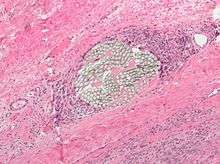Foreign-body giant cell
.jpg)
A foreign-body giant cell is a collection of fused macrophages (giant cell) which are generated in response to the presence of a large foreign body.[1] This is particularly evident with implants that cause the body chronic inflammation and foreign body response.[2] This reaction to the implant causes damages to the infected area, leaving the exterior surface with scars.[3]
The nuclei are arranged in a disorganized manner.[4] The nuclei in this cell are centrally placed and overlap each other.[5] This is in contrast to a Langhans giant cell, where the nuclei are arranged on the border.
Foreign body cells can detect and eliminate bacteria caught within the body, by sensing the unique sugar coating that are on the invading prokaryotes.[6] These macrophage cells are one of a few phagocytic cells, but not the first to come to an injury site, and tend to linger from anytime between days to weeks.[7] There has been some research done on other variations of giant calls with different functions.[8]
Additional images
-

Foreign-body giant cell reaction to a suture. H&E stain.
Small image of an infected area of the body due to a reaction with an implant
References
- ↑ http://www.uweb.engr.washington.edu/research/tutorials/woundhealing.html
- ↑ Foreign Body Giant Cell at the US National Library of Medicine Medical Subject Headings (MeSH)
- ↑ Mcnally, Amy (2003). "Giant Cell Formation". Am. J. Pathol. 163: 1147–56. PMC 1868253
 . PMID 12937156.
. PMID 12937156. - ↑ "Inflammation".
- ↑ "Giant cells in chronic inflammation". Retrieved May 21, 2013.
- ↑ http://www.uweb.engr.washington.edu/research/tutorials/woundhealing.html
- ↑ http://www.uweb.engr.washington.edu/research/tutorials/woundhealing.html
- ↑ Brodbeck, WG; Anderson, JM (2009). "Giant cell formation and function". Curr. Opin. Hematol. 16: 53–7. doi:10.1097/MOH.0b013e32831ac52e. PMC 2679387
 . PMID 19057205.
. PMID 19057205.